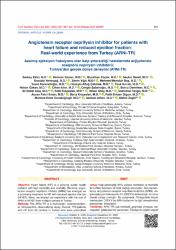Angiotensin receptor neprilysin inhibitor for patients with heart failure and reduced ejection fraction: Real-world experience from Turkey (ARNi-TR)

View/
Access
info:eu-repo/semantics/openAccessDate
2021Author
Ekici, BerkayYaman, Mehmet
Küçük, Murathan
Dereli, Seçkin
Yenerçağ, Mustafa
Yiğit, Zerrin
Baş, Mehmet Memduh
Karavelioğlu, Yusuf
Çakmak, Hüseyin Altuğ
Kıvrak, Tarık
Özkan, Hakan
Altın, Cihan
Şabanoğlu, Cengiz
Demirkan, Burcu
Ataş, Ali Ekber
Kılıçaslan, Fethi
Altay, Hakan
Tengiz, İstemihan
Erkan, Aycan Fahri
Kılıçaslan, Barış
Olgun, Fatih Erkam
Durakoğlugil, Murtaza Emre
Alhan, Aslıhan
Zoghi, Mehdi
Metadata
Show full item recordCitation
Ekici, B., Yaman, M., Küçük, M., Dereli, S., Yenerçağ, M., Yiğit, Z. ... Zoghi, M. (2021). Angiotensin receptor neprilysin inhibitor for patients with heart failure and reduced ejection fraction: Real-world experience from Turkey (ARNi-TR). Archives of the Turkish Society of Cardiology, 49(5), 357-367. https://doi.org/10.5543/tkda.2021.63099Abstract
Objective: Heart failure (HF) is a growing public health problem with high morbidity and mortality. Recently, angiotensin receptor neprilysin inhibitor (ARNi) has emerged as a promising treatment for HF with reduced ejection fraction (HFrEF). Here, we shared our experience with the use of ARNi in HFrEF from multiple centers in Turkey.
Methods: The ARNi-TR is a multicenter, nonintervention al, retrospective, observational study. Overall, 779 patients with HF from 22 centers in Turkey who were prescribed sacubitril/valsartan were examined. Initial clinical status, biochemical and echocardiographic parameters, and New York Heart Association functional class (NYHA-FC) values were compared with follow-up values after 1 year of ARNi use. In addition, the effect of ARNi on number of annual hospitalizations was investigated, and the patients were divided into 2 groups, depending on whether ARNi was initiated at hospitalization or under outpatient clinic control.
Results: N-terminal pro-brain natriuretic peptide (NT-proBNP), left-ventricle ejection fraction (LV-EF), and NYHA-FC values improved significantly in both groups (all parameters, p<0.001) within 1-year follow-up. In both groups, a decrease in hemoglobin A1c (HbA1c) values was observed in ARNi use (p<0.001), and a decrease in daily diuretic doses and hospitalizations owing to HF were observed after ARNi use (all comparisons, p<0.001). Hypotension (16.9%) was the most common side effect in patients using ARNi.
Conclusion: The ARNi-TR study offers comprehensive real-life data for patients using ARNi in Turkey. The use of ARNi has shown significant improvements in FC, NT-proBNP, HbA1c levels, and LV-EF. Likewise, reductions in the number of annual hospitalizations and daily furosemide doses for HF were seen in this study.

















